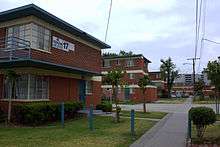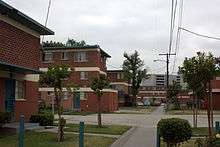William Mead Homes
| William Mead Homes | |
|---|---|
 | |
| Location | Los Angeles, California |
| Coordinates | 34°03′51″N 118°13′47″W / 34.064232°N 118.229805°WCoordinates: 34°03′51″N 118°13′47″W / 34.064232°N 118.229805°W |
| Status | completed |
| Constructed | 1942 |
| Governing Body | Housing Authority of the City of Los Angeles |
William Mead Homes is a public housing development located in Chinatown, a neighborhood of the city of Los Angeles. Nicknamed "Dogtown" because of its proximity to the Ann Street Animal Shelter[1] whose canine residents could be heard for blocks around,[2][3] it is operated by the Housing Authority of the City of Los Angeles.
History
The site was funded with the federal Housing Act of 1937. The proposal to build the site was rejected in December 1940 because of high land purchase costs (averaging $23,900 per acre, when other developments were as low as $2400). 8 acres (3.2 ha) was owned by the Consolidated Steel Corporation.[4][5] The remaining property was on land bequeathed by William Mead, an early Los Angeles politician.[6]
The land price was reduced to $20,000 an acre by January 1941, but didn't proceed until a federally-backed United States Housing Authority loan signed by Franklin D. Roosevelt was given on March 12, 1941.[7][8]
It was built in 1941-1942 and contains 449 units in 24 buildings, replacing approximately 100 substandard dwellings on the site. It occupies 15.2 acres (6.2 ha) and was constructed by the Herbert M. Baruch Corporation for $1.2 million.[9][10][11] David Gebhard and Robert Winter state the details "slightly suggest the late 1930s Moderne."[11][12]

Residency in the project was limited to low-income American citizens who had lived in Los Angeles for at least a year.[7] It was also part of a "Negro quota" system, which mandated a maximum of 7 percent black occupancy. This changed to 15% in January 1943, and was completely removed in July 1943 after pressure and protests by the National Urban League, California Eagle, Los Angeles Sentinel, NAACP, and the CIO union.[13] The development was opened for war workers in March 1943.[14]
Part of the project was built on an oil refinery and a hazardous waste dump. In 1994, cancer-causing polycyclic aromatic hydrocarbons were found at levels 19 times the safe level following testing by the California Department of Toxic Substances Control. Playgrounds and gardening spaces were closed, and a $1.5 million soil removal and cleanup project was required in 2000. The refinery was operated by Amalgamated Oil Company, which was later purchased by Texaco. The waste dump was operated by Witco Corporation, now part of the Chemtura Corporation. At the time, the project was home to 1400 residents, many Latino and Vietnamese.[15][16] The Housing Authority sued ChevronTexaco for the cleanup costs in April 2003.[17][18]
In 1992, the population was 71 percent Latino, 22 percent Asian, 4 percent African-American and 1 percent Caucasian, with a median monthly family income of $840.[19]
Several innovative welfare-to-work programs occurred, such as the Jobs-Plus program, which was at William Mead and Imperial Courts from 1996 to 2002.[20][2][21]
Geography
William Mead Homes is located within the Chinatown neighborhood of Los Angeles. The housing complex is next to two government facilities, the Twin Towers Correctional Facility and the LADWP Main Street Center. Nearby neighborhoods: To the north is Chinatown, to the northeast is Cypress Park, to the east is Lincoln Heights, to the southwest is Boyle Heights, and to the west is Downtown Los Angeles.
In Popular Culture
Several building complexes and a recreational area from the area were used for the 2008 action thriller film Street Kings starring Keanu Reeves.
References
| Wikimedia Commons has media related to William Mead Homes. |
- ↑ "L.A. North Central Animal Care and Control Center Now Open to the Public". Los Angeles Times. March 10, 1988.
- 1 2 "ANALYSIS: JOBS PLUS IS A EXPERIMENTAL PROGRAM DESIGNED TO HELP PEOPLE ON WELFARE FIND JOBS AND HELP THEM TO GET OUT OF POVERTY". NPR. 23 September 1999.
- ↑ Reid, David (1994). Sex, death, and God in L. A. Berkeley: University of California Press. p. 17. ISBN 0-520-08640-6.
- ↑ "One Housing Project Wins". Los Angeles Times. 13 December 1940. p. 12.
- ↑ "Housing Project Again Rejected". Los Angeles Times. 14 December 1940. p. A16.
- ↑ Ingram, James Warren (2008). The Rules of Ruling: Charter Reform in Los Angeles, 1850-2008 (dissertation). University of California, San Diego. p. 342.
- 1 2 "President Approves Loan for Slum Clearance Here". Los Angeles Times. 13 March 1941. p. A1.
- ↑ "We Get Them Anyhow". Los Angeles Times. 17 March 1941. p. A4.
- ↑ Engineering news-record, Volume 128, Part 1. p. 6.
- ↑ Cuff, Dana (2000). The provisional city: Los Angeles stories of architecture and urbanism. Cambridge, Mass: MIT. p. 30. ISBN 0-262-53202-6.
- 1 2 Winter, Robert; Gebhard, David (2003). An Architectural Guidebook to Los Angeles. Layton, Utah: Gibbs Smith Publishers. p. 271. ISBN 1-58685-308-2.
- ↑ "Toxic Cleanup Set at Housing Project". Los Angeles Times. January 21, 2000. p. 4. Retrieved 24 April 2011.
- ↑ Parson, Donald Craig (2005). Making a better world: public housing, the Red Scare, and the direction of modern Los Angeles. Minneapolis: University of Minnesota Press. pp. 32, 68. ISBN 0-8166-4370-9.
- ↑ "Homes Opened for Workers". Los Angeles Times. 16 March 1943. p. A8.
- ↑ "Home, Sweet Dump". LA Weekly. 19 January 2000. Retrieved 24 April 2011.
- ↑ Treviño, Joseph (13 February 2002). "Project Turmoil". LA Weekly. Retrieved 24 April 2011.
- ↑ Stewart, Jocelyn Y. (May 31, 2003). "Los Angeles; Housing Project Site's History of Oil Storage Still Haunts City; L.A. sues firm to offset the cleanup costs for tainted land a predecessor owned". Los Angeles Times. p. B4. Retrieved 24 April 2011.
- ↑ "Central Los Angeles; Soil Near Homes to Be Tested for Oil Waste". Los Angeles Times. December 14, 1995. p. 5. Retrieved 24 April 2011.
- ↑ Yokoi, Iris (November 8, 1992). "Optimistic Mead Residents to Celebrate". Los Angeles Times. p. 10. Retrieved 24 April 2011.
- ↑ "HACLA Presentation" (PDF). 12 August 2010. p. 54. Retrieved 24 April 2011.
- ↑ Meyer, Josh (April 11, 1997). "L.A. Joins Push for Jobs for Public Housing Residents; Aid: Program is called critical to helping families stay in their homes as welfare overhaul raises threat of eviction.;". Los Angeles Times. p. 1. Retrieved 24 April 2011.